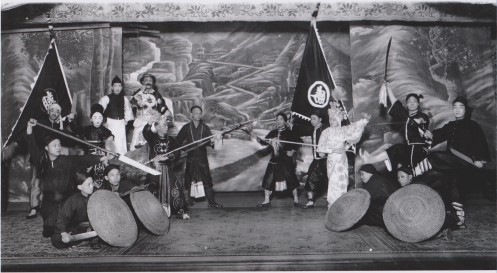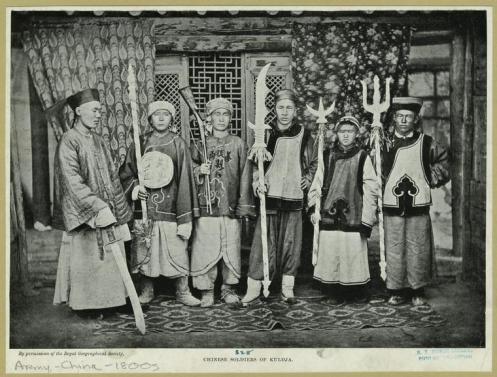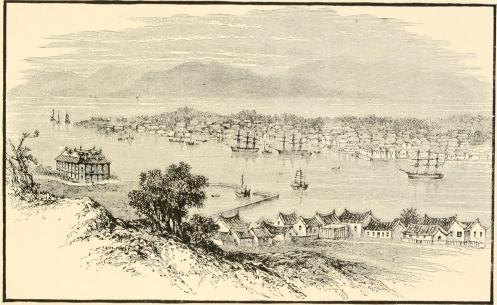Vivid Report of Chinese “Gladiators” Reaches New York in 1891
“China is the last place in the world in which you’d expect to find gladiators, and yet we have them here and very clever ones, too…”
Continued from PART I, which recounted the martial experiences of Dr. Edward Bedloe in China.
THE GLADIATORS OF CHINA
[Special Correspondence of THE ITEM].
NEW YORK, Oct. 23, 1891.
Some time ago I furnished my readers with an account of the manner the Chinese fight by poking their rigid fingers into each other’s eyes and faces. It was sent me by my old friend, Dr. Bedloe, U.S. Consul at Amoy. Last week I received from him the following account of the style of combats now prevalent among Chinese gladiators. I wonder if the Romans took this style of combat from the Chinese:
“China is the last place in the world in which you’d expect to find gladiators, and yet we have them here and very clever ones, too. They form a separate profession, or guild, to themselves. They are included under the head of actors by the Celestial lawmakers, but look down upon the average Thespian as a Pariah of the poorest type. The tricks of the trade are taught by father and son, and it is impossible to attain a high proficiency unless one has been practiced and trained, from infancy up.
“Their performance is two hours long and consists of all sorts of feats of arms with swords, daggers, war-axes, shields, spears and tridents…”

Cantonese Opera Performers in San Francisco, circa 1900, exhibiting some of the same type of weapons as in Bedloe’s account. Source: http://chinesemartialstudies.com/
Their performance is two hours long and consists of all sorts of feats of arms with swords, daggers, war-axes, shields, spears and tridents. The weapons have no edges or points, of course, as in the heat of action the gladiators at times, inflict pretty heavy blows. In some cases the spears and tridents have the points topped with leather covers that resemble miniature boxing gloves. The swords are lighter and shorter than ours, weighing scarcely more than dueling rapiers. They have no guards to the hilt. The spear and tridents have thin bamboo handles, the lightest and strongest wood there is. The shields are made of rattan and bamboo; they weigh but little, but will successfully resist a heavy spear thrust or a powerful sword blow. Much of the fighting is like Italian fencing or the Zouave sword against bayonet drill. But even these are thrown so many barbarian tricks and muscular feats that the resemblance is very slight. The most interesting to me was trident against sword and shield. The contestants were undersized men, but so sinewy and fine, from years of professional work, that they seemed a mass of muscles. Their costume was a single garment that would have passed muster as bathing trunks.
“The ‘tridenter’ was as agile as a cat and ran around his adversary never stopping…”
When ‘time’ was called they approached within ten feet of each other, saluted, and entered into action. Each touch, by trident on the one side, or sword on the other, counts a point. A round lasts ten minutes, when a well-earned recess is taken for three or four minutes, until the fighters have cooled off sufficiently. The ‘tridenter’ was as agile as a cat and ran around his adversary never stopping. He would feint and thrust rapidly, now at the head, then chest, now the loins and then the shins. Usually the swordsman would stop the blow with his shield held obliquely so as to make the trident glance off and let its holder be carried forward by the impetus of the blow. When he succeeded in this, and it was very rare, he would get in a rousing blow with the flat of his sword. In some cases he would spring sideways, and parry the trident with his sword and with a circular sweep of the wrist of a return lunge endeavor to strike his antagonist. To my eyes the honors were about even, but some Chinese friends said that the tridenter had won and in real battle would have killed the swordsman.
“The fencing was extraordinary…”
Quick, novel and exciting was the two-sword contest. To each gladiator was given a sword in a scabbard. They saluted, drew swords and dropped the sheaths. To my surprise the sword was double, the same as if a hilt were split in half, and to each half a blade affixed. The weapons were double-edged though of course dull and pointless. The fencing was extraordinary. It had in it some of the features of our sabre practice, but was as quick and nervous as a French foil assault. The men were here, there, and everywhere, the four muscular arms and the four steels seemed whirling in every direction. Now and then a storm of applause would follow the heavy ‘thwack’ given by the flat of the sword, when one of the men got an opening, but the work was too rapid for my barbarian eye to appreciate its artistic value. But it was wonderful as a mere matter of acrobatics.

“Chinese soldiers of Kuldja.” (1902). Royal Geographical Society. Source: http://chinesemartialstudies.com/
These martial feats, I am told, are very common in the interior of China, where there are regiments today armed as in the dead years of Timour the Tartar, to whom the revolver, riddle and cannon are unknown. In the coast provinces the armies are European in equipment and drill, and have been for fifty years. The gladiator in these districts is no longer a soldier, as in Ho Nan and Sze-Chuen, but a juggler and a strolling player.”
It seems that the love of physical prowess is universal.
MACON (McCormick.)
– Reported in the New Orleans Item, October 27, 1891.
***
NOTE: For further reading on Kung Fu in nineteenth century America, see The First Exhibition of Kung Fu and Chinese Martial Arts in America: Brooklyn, 1890.
Also, the images of combatants in this article come from the Kung Fu Tea blog, which we highly recommend.




Excellent find! Thanks for posting this. Definitely one of the best accounts of Chinese boxing that I have seen from that period.
LikeLike
Thanks, Ben! Some other interesting accounts to follow…
LikeLike